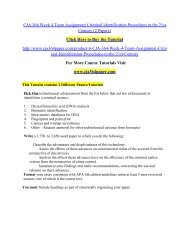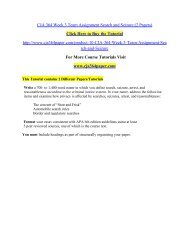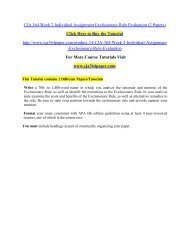CJA 364 Week 5 Final Exam/ cja364paperdotcom
You also want an ePaper? Increase the reach of your titles
YUMPU automatically turns print PDFs into web optimized ePapers that Google loves.
<strong>CJA</strong> <strong>364</strong> <strong>Week</strong> 5 <strong>Final</strong> <strong>Exam</strong><br />
Click Here to Buy the Tutorial<br />
http://www.cja<strong>364</strong>paper.com/product-22-<strong>CJA</strong>-<strong>364</strong>-<strong>Week</strong>-5-<strong>Final</strong>-<strong>Exam</strong><br />
For More Course Tutorials Visit<br />
www.cja<strong>364</strong>paper.com<br />
Matching<br />
Identify whether the following concept agrees with the Crime Control Model (A) or the<br />
Due Process Model (B). Try to think in terms of which favors the police (Crime Control) &<br />
which favors the defendant (Due Process).<br />
A. Crime Control B. Due Process<br />
1. Exclusionary Rule 6. Legal guilt<br />
2. “Stop and Frisk” 7. Conveyor belt/assembly line<br />
3. Miranda warnings 8. Speed and finality<br />
4. Plea bargains 9. Factual guilt<br />
5. Innocent until proven guilty 10. Obstacle course<br />
True-False<br />
If you feel the statement is falsemake sure you show how it could become a true statement<br />
in your own words (identify the main concepts and add this information under the question).<br />
11. In Illinois v. Gates, the U.S. Supreme Court established the two-pronged test<br />
which is used as a review for warrants obtained via informants’ tips.<br />
This is referred to as the Aguilar–Spinell two-pronged test.<br />
12. The Crime Control Model believes that a suspect is innocent until proven<br />
guilty and the main focus for the court should be the “legal” guilt.<br />
This is the due process model.<br />
13. A “stop and frisk” search, based on the case of Terry v. Ohio, allows police to<br />
single out any individual and search them based solely on the officers<br />
unsupported hunch.<br />
This is true only when the officer has reasonable suspicion that the subject is armed and<br />
dangerous. A “stop and frisk” allows the officer to frisk for weapons only.<br />
14. Probable cause can be based on an officer’s personal observations,<br />
knowledge from the officer’s training and experience, reliable (proven)<br />
informant tips, or by corroborating tips through investigation.<br />
15. The Exclusionary Rule prohibits police from using anonymous informants in
obtaining evidence against a suspect.<br />
The exclusionary rule prohibits police from using evidence obtained from an<br />
unconstitutional search or seizure.<br />
Multiple choice<br />
Choose the best answer from the choices provided.<br />
16. Police officers need to establish the following for a valid consent search:<br />
a. an adult with apparent authority & control over the thing or place to be<br />
searched<br />
b. a signed permission waiver<br />
c. voluntary, un-coerced consent<br />
d. a & c only<br />
17. The following are all valid exceptions to the Fourth Amendment warrant<br />
requirement, except:<br />
a. Abandoned property recovered in an unsecured area<br />
b. Contraband seen in plain view by police<br />
c. Police searching someone incident to arrest<br />
d. When there is potential danger to someone’s safety or to stop the<br />
imminent destruction of evidence<br />
e. Entering an apartment because a neighbor says she smells marijuana<br />
smoke from within and is sure the residents are using and selling drugs<br />
18. The process by which the prosecutor and the defense attorney, along<br />
with the judge, question potential jurors in order to identify those who may have a<br />
bias toward the defendant is known as:<br />
a. reasonable doubt<br />
b. res ipsaloquitor<br />
c.commutative association<br />
d. voir dire<br />
e. totality of the circumstances<br />
19. Based on Miranda v. Arizona, when must police officers advise a subject of<br />
their rights (to remain silent and the right to have an attorney)?<br />
a. when they first arrive at the scene of a call-for-service<br />
b. once the police have taken the suspect into custody and will be asking<br />
questions intended to elicit a confession from the suspect<br />
c. when the subject says he knows his rights<br />
d. after the police have talked to the victim and/or witnesses<br />
20. A person has a right to an attorney based on the Sixth Amendment in which<br />
of the following circumstances:<br />
a. during an investigatory or traffic stop<br />
b. at a photo array identification<br />
c. at an arraignment or bond hearing<br />
d. none of the above
Fill in the Blanks. By all means, use your Internet and look these up. I’m not allowed to give<br />
any extra credit, so think kindly on me for these last five questions. THIS IS NOTEXTRA<br />
CREDIT YOU MUST ANSWER THESE QUESTIONS.<br />
21. Clemenza: “Leave the gun. Take the cannoli.”<br />
22. Chief Hubbard: “Is this the man who crashed through Victor Maitland’s window.”– you<br />
have several options here, only one is necessary.<br />
23. Callahan: “I know what you’re thinking, punk. You’re thinking, ‘Did he fire six shots<br />
or only five?’ Now to tell you the truth I forgot myself in all this excitement. But being this<br />
is a .44 Magnum, the most powerful handgun in the world and will blow your head clean<br />
off, you gotta ask yourself a question: ‘Do I feel lucky?’ Well, do ya, punk?”<br />
24. Waiter: “Would you like some drinks, Señor, while you wait? I will put it on the<br />
Underhills’ bill.”<br />
Fletch: “Yes, very good. I’ll have a Bloody Mary and a steak sandwich and…a steak<br />
sandwich, please<br />
25. Elwood: “I bet these cops got SCMODS.”<br />
Jake: “SCMODS?”<br />
Elwood: “State County Municipal Offender Data System.”
















